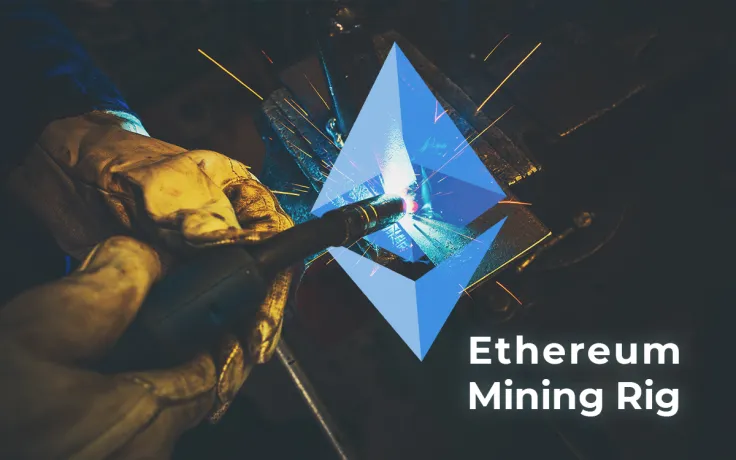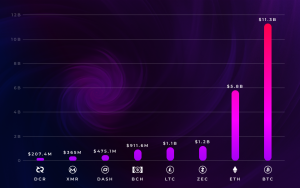
Still dreaming of passive income? Why not building an Ethereum mining rig? In this guide, you will learn to select special mining hardware and install it step-by-step to create your own home mining rig.
While Bitcoin mining is losing its popularity, Ethereum mining is still relevant and potentially profitable. However, things have changed, and a simple PC isn’t enough to get a decent amount of Ether – what you need is a mining rig. While it’s working, you can sleep soundly and reap the rewards.
Let’s find out how to build an Ethereum mining rig that will both cost-efficient and affordable. With this step-by-step guide, you will create a mining rig at home on your own.
What is mining? Why do I need to mine Ethereum?
In fact, mining is what maintains the integrity of data and functioning of the crypto environment, and Ethereum isn’t an exception. Thanks to mining, any change to the dapps (decentralized applications) from the network are registered. Therefore, mining helps to verify and validate the data transfer and transactions performed in Ethereum network.
Mining is done by contributors (miners) who provide their computers and servers for operation processing. In return for doing the calculations on their computers, they are rewarded by Ether coins. But the problem here is that mining is gradually taking more computational power with the time being, so people have to invest in more advanced hardware. Mining difficulty is increasing due to the growing number of people who get involved in mining and competing for Ether reward. If you could build Ethereum mining rig in 2017 and offset expenses pretty soon, in 2018, it’s not likely.
Does that mean that mining is becoming unprofitable? It’s a controversial question. When the difficulty gets too high, the number of Ether coins you receive doesn’t cover the expenses for electricity and cooling. As a rule, when that happens, people move to another coin, and Ethereum mining becomes profitable again.
One more reason why people keep mining Ethereum even if it’s unprofitable is the forecast concerning its cost. While one Ether is about $770-$790 now, in a few years, it can grow up to $3,000-$3,500. Therefore, the value of the coin is expected to rise seriously in the future.
Mining rig vs. Usual PC
A mining rig is basically made of the same elements that are installed in a regular desktop computer. But there’s some minor difference:
|
Desktop computer |
Gaming computer |
Mining Rig |
|
CPU, RAM, GPU, and HD are balanced |
Advanced versions of CPU, a lot of RAM, a couple of GPUs and SDDs. |
The lowest clocked CPU, minimum RAM, 5-7 GPUs and a basic HD. |
Of course, you won’t be able to place several GPUs in a usual computer case, so you need a special container for them.
Buying equipment
In order to build Ethereum mining rig, you need to purchase numerous components. Let’s quickly observe them:
-
A rig frame for at least eight GPUs. Ideally, you need to find someone to build a frame for you. Alternatively, you can visit the nearest hardware store and make it yourself. It will cost you about $30, but you can replace it with something non-expensive like a milk crate.
-
Motherboard. Purchase it in the nearest store, in Amazon or eBay. Avoid buying used devices – it’s not reliable. Find a model that has slots for up to six GPUs and allows adding more via an adapter. ASUS PRIME Z270P is highly recommended for this purpose.
-
CPU. It doesn’t really matter which one you take. It’s better to select a “box” edition because it features a fan and the warranty period is usually longer.
-
Hard drive. Modern SSD drives are highly recommended for mining: they have optimal operational speed and fast boot time. About 60-80 Gb will be enough for the start.
-
RAM. Use DDR4 type solely. Kingston is pretty reliable and affordable. A four Gb RAM-card is optimal for mining.
-
Power supply units. Three units will be enough for one mining rig. One unit is worth about $100. Some users prefer non-expensive Chinese PSU, but if you don’t want to risk, try brand models. For instance, Corsair CX750M units are connected with GPUs with cables that are included in the package.
-
Risers. One riser per GPU, each is worth $10– all in all, you’ll have to spend about $80.
-
M2 to PCI Adapters. You need two adapters for one rig. You can order a $10 adapter in China, but not all of them work correctly and can let you down.
-
Display emulator (adapter from HDMI to VGA) costs about $10, and you need it to specify the optimal screen resolution in TeamViewer.
-
Power supply adapters. You need two adapters for one mining rig. If you install some powerful Chinese PSU (the one that can be connected to all GPUs), you won’t need these adapters at all.
Additionally, you can purchase WatchDog 2.0. It’s an electronic timer that can reboot your rig in case of downtime or shortage of Internet connection.
All the above-mentioned spare parts will cost you about $700-750, which doesn’t seem much. But, wait, here comes the most expensive part – GPU units. For instance, if you select Nvidia 1070, each of which is worth $500, overall expenses will exceed in 4,700. That’s a considerable sum.
Choosing the best GPU
Building an Ethereum mining rig is impossible without installation of graphic processing units (GPU). Let’s observe the ones that are suitable for mining and evaluate the hash rate and power consumption.
|
Radeon RX Vega 64 |
33 MH/sec |
200 Wt |
|
Radeon RX Vega 56 |
31 MH/sec |
190 Wt |
|
GeForce GTX 1080 TI |
32 MH/sec |
200 Wt |
|
GeForce GTX 1070 |
27 MH/sec |
200 Wt |
|
GeForce GTX 1060 |
20 MH/sec |
110 Wt |
|
Radeon RX 580 |
25 MH/sec |
175 Wt |
|
Radeon RX 480 |
24 MH/sec |
170 Wt |
|
Radeon RX 570 |
22 MH/sec |
125 Wt |
|
Radeon RX 470 |
21 MH/sec |
120 Wt |
|
Radeon R9 290X |
28 MH/sec |
280 Wt |
The process of installation
Now when the spare parts are ready, we come to learn how to build Ethereum mining rig from scratch. Start with the basic steps:
-
Attach the CPU to the motherboard, then install RAM and the fans.
-
Connect SSD drive using SATA cable.
-
Connect one PSU– it will serve as the main unit.
-
Mount one GPU.
Now it’s time to launch your rig. Open BIOS, don’t forget to update it. If you need to install BIOS, copy the file of its latest version to a USB flash drive, press F7 to proceed to the advanced settings, find ASUS Flash Utility, select ‘By USB’ and choose your flash drive file.
After BIOS installation/updating, configure the motherboard for mining. Go to Advanced settings (F7), disable HD Audio Controller, Serial Port 1, and LED Lighting, select Gen2 for link speed, and choose PCIE for primary display and M.2_1 configuration. Don’t forget to active Restoration of AC Power Loss.
Now it’s time to select the operating system. There are two basic options available:
-
If you’re used to Linux, try EthOS– it’s a 64-bit Linux OS that can be exploited to mine Ethereum, Monero, Zcash and other coins.
-
If Windows is more convenient for you, opt for Windows 10. In this case, you’ll need additional mining software.
Install the operating system. Select default installation and disable the features that you don’t need. Set up the Internet connection and get motherboard drivers from the official websites of software providers. Change the size of the virtual memory: for instance, if turn your 80 Gb into 30,000 Mb. You will also need remote control software.
Depending on the type of graphics unit you’ve bought, download AMD or Nvidia driver. Install it, reboot the rig and make sure that everything is working properly. Reboot the rig one more time, proceed to BIOS and enable ‘Above 4G decoding.’ Switch the power off, mount all the rest GPUs. The monitor should be better connected to the first card. Keep the cables plugged in, so that the GPU and the risers were powered from the same PSU.
Turn on the rig and wait until Windows detects all other GPUs one by one- it may take pretty much time, but don’t worry. If you already have TeamViewer installed, you can keep tabs on your rig and check how things are working. Windows Device Manager is used for monitoring.
If some GPUs aren’t installed correctly, you’ll see warning ‘Unknown Devices:’ to solve this problem, you need to install the driver manually and specify the paths. If you use AMD GPUs and see ‘!’ points next to them, open AMD atikmdag Patcher and click ‘Yes’ - the issue will disappear after rebooting.
Additional steps
In order to prevent downtime, you can use WatchDog that will reboot your rig in case of power outage. Connect it to Power and Reset connections on your motherboard, install the program and the drivers. Activate ‘Autostart’ for the program, and specify monitoring settings. Don’t forget to activate monitoring by typing in ‘cmd.exe.’
Here’s something else you may need:
-
Prevent the system from going to sleep mode by changing power settings.
-
Install Afterburner to overclock your GPUs.
-
If you’re planning to build several rigs, install controlling software (Awesomeminerwill do).
Bottom line
Despite the rising difficulty of Ethereum mining, this process still makes sense – the value of coins is expected to grow five-fold in the upcoming years, so your expenses are likely to be covered. Even if you suddenly change your mind, the mining rig you’ve built can be used to obtain any GPU-mined coin (there are hundreds of them).


 Dan Burgin
Dan Burgin Vladislav Sopov
Vladislav Sopov U.Today Editorial Team
U.Today Editorial Team